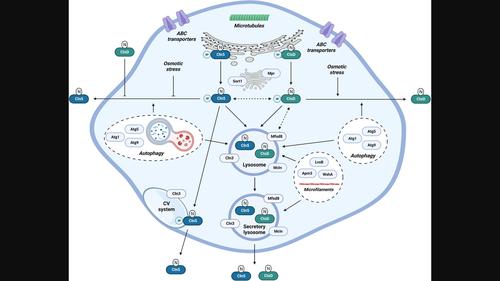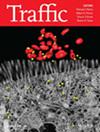调节 CLN5 和 CTSD 细胞内贩运和释放的机制
IF 2.5
3区 生物学
Q3 CELL BIOLOGY
引用次数: 0
摘要
类神经细胞色素脂褐质沉着病神经元 5(CLN5)和凝血酶 D(CTSD)是可溶性溶酶体酶,也可在细胞外定位。在人类中,CLN5 和 CTSD 的同基因突变分别导致 CLN5 病和 CLN10 病,这是神经细胞类脂质硬化症(俗称巴顿病)的两个亚型。CLN5和CTSD在细胞内的转运及其从细胞中释放的调控机制尚不十分清楚。在这里,我们以社会阿米巴盘基变形虫为模型系统,研究了调节人类 CLN5(Cln5)和 CTSD(CtsD)的盘基变形虫同源物的胞内运输和释放的途径和细胞成分。我们的研究表明,Cln5 和 CtsD 都含有促进它们从细胞中释放的分泌信号肽。与 Cln5 一样,细胞外的 CtsD 也是糖基化的。此外,Cln5的释放受细胞外CtsD数量的调节。自噬诱导可促进 Cln5 的释放,在较小程度上也可促进 CtsD 的释放。Cln5 的释放需要自噬蛋白 Atg1、Atg5 和 Atg9 以及自噬体-溶酶体融合。CtsD的释放需要Atg1和Atg5。总之,这些数据支持这样一个模型,即 Cln5 和 CtsD 通过其分泌信号肽以及与自噬相关的途径从细胞中主动释放出来。Cln5和CtsD从细胞中释放出来还需要微丝和盘状核虫同源的人类AP-3复合体μ亚基、溶酶体贩运调节因子LYST、粘蛋白-1和Wiskott-Aldrich综合征相关蛋白WASH,它们在该模式生物中都能调节溶酶体的外泌。这些研究结果表明,溶酶体外泌也有助于 Cln5 和 CtsD 从细胞中释放出来。此外,我们还报告了ABC转运体、微管、渗透压以及人类索氏蛋白和阳离子依赖性甘露糖-6-磷酸受体的D. Discoideum推测同源物在调节Cln5和CtsD的胞内/胞外分布中的作用。总之,这项研究确定了调节盘形盘虫细胞中Cln5和CtsD释放的细胞机制,并深入探讨了CLN5和CTSD的贩运改变如何导致人类疾病。本文章由计算机程序翻译,如有差异,请以英文原文为准。

Mechanisms regulating the intracellular trafficking and release of CLN5 and CTSD
Ceroid lipofuscinosis neuronal 5 (CLN5) and cathepsin D (CTSD) are soluble lysosomal enzymes that also localize extracellularly. In humans, homozygous mutations in CLN5 and CTSD cause CLN5 disease and CLN10 disease, respectively, which are two subtypes of neuronal ceroid lipofuscinosis (commonly known as Batten disease). The mechanisms regulating the intracellular trafficking of CLN5 and CTSD and their release from cells are not well understood. Here, we used the social amoeba Dictyostelium discoideum as a model system to examine the pathways and cellular components that regulate the intracellular trafficking and release of the D. discoideum homologs of human CLN5 (Cln5) and CTSD (CtsD). We show that both Cln5 and CtsD contain signal peptides for secretion that facilitate their release from cells. Like Cln5, extracellular CtsD is glycosylated. In addition, Cln5 release is regulated by the amount of extracellular CtsD. Autophagy induction promotes the release of Cln5, and to a lesser extent CtsD. Release of Cln5 requires the autophagy proteins Atg1, Atg5, and Atg9, as well as autophagosomal-lysosomal fusion. Atg1 and Atg5 are required for the release of CtsD. Together, these data support a model where Cln5 and CtsD are actively released from cells via their signal peptides for secretion and pathways linked to autophagy. The release of Cln5 and CtsD from cells also requires microfilaments and the D. discoideum homologs of human AP-3 complex mu subunit, the lysosomal-trafficking regulator LYST, mucopilin-1, and the Wiskott–Aldrich syndrome-associated protein WASH, which all regulate lysosomal exocytosis in this model organism. These findings suggest that lysosomal exocytosis also facilitates the release of Cln5 and CtsD from cells. In addition, we report the roles of ABC transporters, microtubules, osmotic stress, and the putative D. discoideum homologs of human sortilin and cation-independent mannose-6-phosphate receptor in regulating the intracellular/extracellular distribution of Cln5 and CtsD. In total, this study identifies the cellular mechanisms regulating the release of Cln5 and CtsD from D. discoideum cells and provides insight into how altered trafficking of CLN5 and CTSD causes disease in humans.
求助全文
通过发布文献求助,成功后即可免费获取论文全文。
去求助
来源期刊

Traffic
生物-细胞生物学
CiteScore
8.10
自引率
2.20%
发文量
50
审稿时长
2 months
期刊介绍:
Traffic encourages and facilitates the publication of papers in any field relating to intracellular transport in health and disease. Traffic papers span disciplines such as developmental biology, neuroscience, innate and adaptive immunity, epithelial cell biology, intracellular pathogens and host-pathogen interactions, among others using any eukaryotic model system. Areas of particular interest include protein, nucleic acid and lipid traffic, molecular motors, intracellular pathogens, intracellular proteolysis, nuclear import and export, cytokinesis and the cell cycle, the interface between signaling and trafficking or localization, protein translocation, the cell biology of adaptive an innate immunity, organelle biogenesis, metabolism, cell polarity and organization, and organelle movement.
All aspects of the structural, molecular biology, biochemistry, genetics, morphology, intracellular signaling and relationship to hereditary or infectious diseases will be covered. Manuscripts must provide a clear conceptual or mechanistic advance. The editors will reject papers that require major changes, including addition of significant experimental data or other significant revision.
Traffic will consider manuscripts of any length, but encourages authors to limit their papers to 16 typeset pages or less.
 求助内容:
求助内容: 应助结果提醒方式:
应助结果提醒方式:


